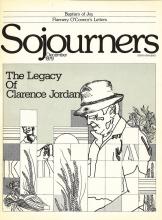The birth that transformed the world came quietly upon us in the barren chill of a stable, and its meaning was not fully realized until the violent death-event on a cross 33 years later. Life and death are inextricably interwoven. In [the December 1979] issue, we commemorate[d] the 10th anniversary of Clarence Jordan's death by celebrating his life and the enduring evidence of his vision.
It is a Sojourners tradition to remember the lives of Christians who have taught us the meaning of the incarnation. Clarence was such a Christian.
Born in the deep South near the beginning of this century, Clarence gained a reputation first as a preacher. In 1942, he began an experiment in racial reconciliation on a farm near Americus, Georgia, which became the target of local white hostility. Called Koinonia, the community thrives today, steeped in the legacy of Clarence's commitment to the partnership of black and white, poor and rich.
Clarence's most widely known contribution is his unique "Cotton Patch" versions of the New Testament scriptures. In his translation, he brought the biblical characters home and set them in the towns, on the roads, and between the cotton and peanut rows of southern Georgia.
In the introduction to his Cotton Patch Version of Luke and Acts, Clarence states:
Jesus has been so zealously worshiped, his deity so vehemently affirmed, his halo so brightly illumined, and his cross so beautifully polished that in the minds of many he no longer exists as a man. He has become an exquisite celestial being who momentarily and mistakenly lapsed into a painful involvement in the human scene, and then quite properly returned to his heavenly habitat. By thus glorifying him we more effectively rid ourselves of him than did those who tried to do so by crudely crucifying him.
Read the Full Article

